The Merry-Go-Round staff is proud to present our top films of 2019
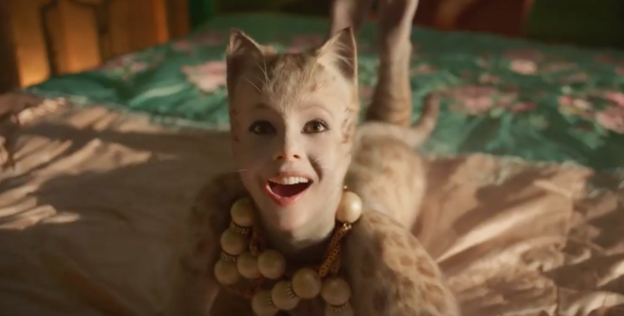
Special Mention: CATS
CATS actually received enough votes to put it in the #32 slot, but we didn’t want the film to get lost in the shuffle of other, genuinely great films, so we decided to give it a special shout out for the so-bad-it’s-good cult status it is sure to attain
Here’s the rub: once you’ve seen CATS, it is impossible to stop thinking about it. Somewhere between yelling at Victoria to shut up and being vocally horny for Skimbleshanks the Railway Cat, I realized that we live in a world of vanilla box office monotony. The fact that CATS can be released on Christmas weekend as counter-programming for Star Wars is a miracle! And y’know why? I’m going to say it here, folks: CATS is good! Sure, it’s not for everyone, not every good movie is (see: UNCUT GEMS), but the music slaps, the dancing is fun, the production design is pretty cool, it’s interesting, and, in this dark world we live in, it made me jubilantly happy for like… Three whole weeks.
So as we begin our annual gathering to make our choice for the best film of 2019, CATS may not be our #1 choice (or our #32 choice), but it is our jellicle choice. Our dear little choice. I unabashedly, unironically, and sincerely love this film and I am so excited to see its meteoric rise to ROCKY HORROR status. And you KNOW I’ll be there in red high-waisted pants and tap shoes. [Kate Brogden]
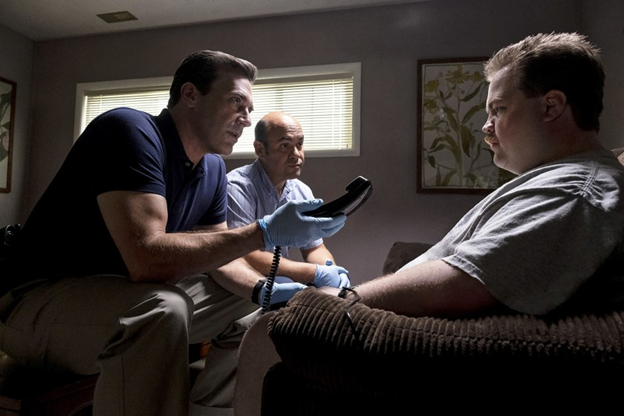
50. RICHARD JEWELL
Director: Clint Eastwood
RICHARD JEWELL marks a return to form for Eastwood, a true sphincter-clencher that sweeps the director’s last few duds out of mind, thanks in no small part to the stellar cast. Paul Walter Hauser’s turn as the eponymous patsy of a corrupt investigation is one of the most underrated performances of 2019. Hauser’s cow-eyed adherence to the law and general gullibility make him the perfect whipping boy for Jon Hamm, who has had too few roles since MAD MEN that he can really sink his claws into. Watching Jewell’s evisceration by the FBI is excruciating, and I found myself yelling “Shut the fuck up!” at the screen just as many times as the hapless security guard’s mom and lawyer, ably depicted by Kathy Bates and Sam Rockwell, respectively. Altogether, RICHARD JEWELL is a deft critique of the media and big government from an old, white, right-leaning icon that somehow doesn’t come off as blustery or myopic, which I think is a credit to Eastwood’s talent as a storyteller. [Ed Dutcher]
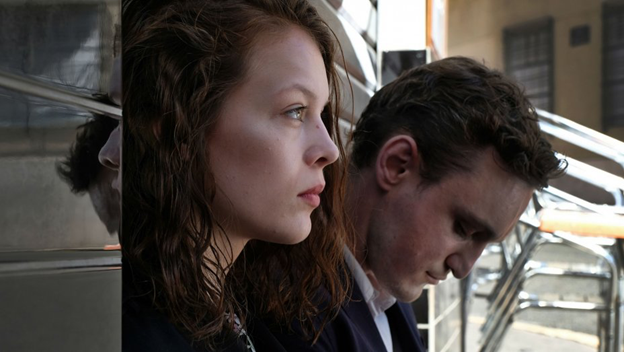
49. TRANSIT
Director: Christian Petzold
Kafka-esque CASABLANCA! Christian Petzold has yet to make a masterpiece, despite arguably being considered the preeminent director of contemporary German cinema. But he comes closest with this, a meditation on what it means to spend eternity in purgatory. A purgatory defined by the physical prisons of war-ravaged borders and the emotional prisons of love. A film that, like a bag of tea, is slow to steep and imbue its color, but whose steam ultimately envelopes your mind with its thematic floral pungency. One that runs dangerously close to Philosophy 101 (Kierkegaard and Sartre would love it), and yet feels insightful when brought to life with fresh-faced performances. Haunted glances in a café bar, vistas of water from a balcony, Petzold’s obvious fascination with wandering women in red dresses—these are my raw visual impressions from the film. And yet its ineffable strength lies in pondering the questions it asks. What is a state? What is a person? Apparently, both are random designations meant to randomly make sense of an otherwise chaotic world. It is a film defiantly out of time, based on a 1940s novel set in WWII (and early-on even featuring a piece of stationary that dates it in the 1940s), despite an unquestionably modern setting in a European city that, like Costa-Gavras’ Z, might as well be Anywhere. [Reid Antin]
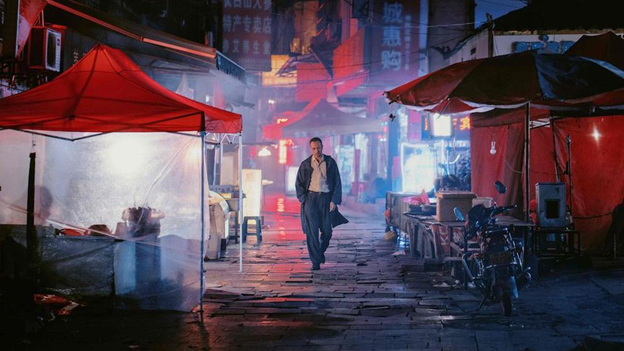
48. A LONG DAY’S JOURNEY INTO NIGHT
Director: Bi Gan
In Bi Gan’s undeniably audacious LONG DAY’S JOURNEY INTO NIGHT, viewers are swept into a Tarkovsky-esque technical marvel that commands its scenery with the finesse, style, and confidence to rival any of the great “oner” movies to release in the 2010s. And look, say what you will about its script, there’s no denying that the transition into 3D and the bold decision to throw in the film’s title card an hour into its running time can confidently rank as one of the very best moments of 2010s’ cinema. It’s a film that can safely sit as one of the most singular works of the new millennium: totally unique and brilliantly stylized. The one-take will continue to be the talking point here for years to come, but I actually think it’s the individual ideas within this oner, and not the actual 50-minute shot in and of itself, that will stand the test of time. A chairlift slowly descending down into the dreamy village. A horse dropping a cart of apples. A drone flying over a karaoke show. A firework sizzling in an empty room. Sure, these are all interwoven through one nauseatingly complex long-shot, but it’s the single moments that are most indelible. The way Bi Gan so elegantly plays with dream logic without ever being in your face about it is outstanding; A sense of magical realism that closely resembles Apichatpong Weerasethakul in the best way possible. [Sergio Zaciu]
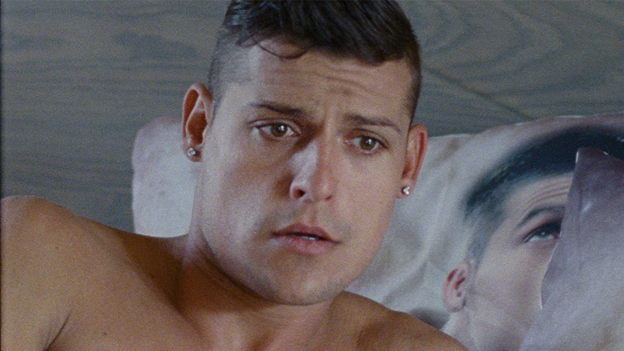
47. DIAMANTINO
Director: Gabriel Abrantes and Daniel Schmidt
I’ve seen DIAMANTINO twice. It slaps without fail. It’s cute, zany, expressive, political, and just pervy enough to somehow never really cement itself as a work of arthouse cinema or full-on exploitation. Telling the story of a soccer icon who decides to adopt an African refugee, DIAMANTINO already starts as a peculiar little picture, but it is absolutely demented in how often it jumps the shark as its web of intrigue builds, revealing plots of fascist propaganda, lesbian secret agents, and DNA cloning that results in… the male subjects growing boobs? It is totally bonkers and kind of amazing that a film this silly can find its way into the upper echelon of Cannes’ Critics Week. Just a really delightful film that effortlessly segues from cute to stupid like some arthouse DUMB & DUMBER. Really love the visual style and how unashamed it is of its wonky visual effects and B-movie aesthetics. Basically the auteur grindhouse film that Robert Rodriguez never made. [Sergio Zaciu]
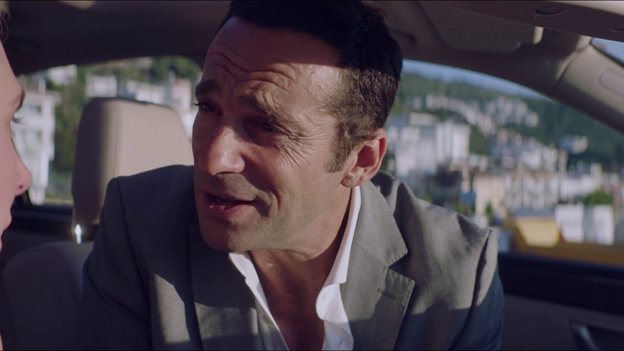
46. Holiday
Director: Isabella Eklöf
We don’t talk about Isabella Eklöf’s HOLIDAY, and it’s a damned shame. Operating somewhere between a Ruben Östlund comedy and a Michael Haneke thriller, HOLIDAY sends the Danish girlfriend of a drug baron on vacation to Turkey, where a complex love triangle brings danger upon herself and the unwitting man who is seeking her affection. Denmark and Sweden really have a way with words and interpersonal behavior, and Isabella Eklöf follows right in Östlund’s footsteps as a brilliant analyst of human insecurities. Right down to the jokes these characters tell each other and the naive means in which they flirt, HOLIDAY perfectly understands that the subtext of everything we say is rooted in what we most fear people will someday learn about us. It’s not quite as clever with its inciting incidents as FORCE MAJEURE or THE SQUARE, but I’ll be damned if it doesn’t have one of my favorite ensembles I’ve seen in a western European comedy. I mean, damn, talk about an awesome setting! [Sergio Zaciu]
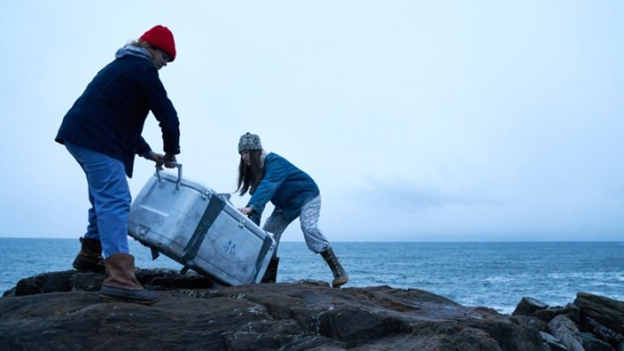
45. BLOW THE MAN DOWN
Director: Bridget Savage Cole and Danielle Krudy
Perhaps the most satisfying blind-viewing experience I had all year, BLOW THE MAN DOWN is a Maine-set FARGO-type with supporting turns from Margo Martindale and June Squibb: a brilliantly twisted small-town noir that expertly uses its ensemble’s varying perspectives (and intentions) in order to form a sinister web of cover-up, power plays, detective work, and murder. This had me from the opening frame with its superb use of a sea shanty-singing Greek chorus, but what really seals the deal is the film’s seamless transition from pulp-thriller to small-town mystery. As the curiosities of its setting start piling up on top of one another, debut directors Danielle Krudy and Bridget Savage Cole introduce an incredibly complex and wonderfully written ensemble of older female characters, all of whom are initially disregarded as part of the world’s local gossip, but take on an incredible sense of agency and menacing power over the course of the film. It’s so damn clever and rewrites the stereotype of the catty grandma with razor-sharp chutzpah. A true sight to behold, and a banger of a debut! [Sergio Zaciu]
 44. JOKER
44. JOKER
Director: Todd Phillips
I want to make it very clear that I think JOKER is dumber than a stack of shit, headlined by a superficial portrayal of mental illness smeared on sloppier than Heath Ledger’s Party City clown kit in THE DARK KNIGHT. That being said: Wow! Joaquin Phoenix is a phenom in this role, constantly delivering the creeps and the occasional laugh as a deranged gunman with delusions of grandeur. Phillips’ vision of Gotham, while too overproduced to feel as grimy as, say, UNCUT GEMS, is a decadent urban hellscape, quintessentially comic book in aesthetic and the perfect playground for Phoenix. While the writing frequently falters, the entire pastiche is Baby’s First Scorsese, and yes, these awards season acting snubs are bullshit, JOKER’s powerhouse lead does deserve all the accolades he’s won. To Phillips’ credit, he picked one of the greats to copy, and it’s a pretty good counterfeit. [Ed Dutcher]
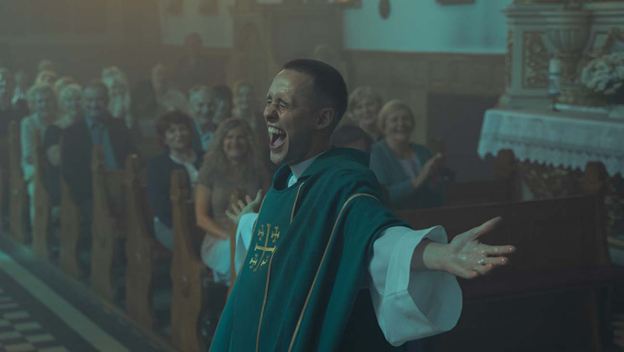 43. CORPUS CHRISTI
43. CORPUS CHRISTI
Director: Jan Komasa
It’s really a shame that PARASITE stole every conceivable inch of the foreign film spotlight this year, because I can’t really name many other years that boasted as many high-quality international heavy-hitters as 2019. In any other year, Jan Komasa’s CORPUS CHRISTI would be a surefire frontrunner for the Academy Award. And though this beautiful little film did find its way into the final list of nominees, it’s surely been overshadowed by the company it’s surrounded by. In this based on a true story drama of an ex-con who finds God in prison, CORPUS CHRISTI dissects what it really means to be a Christian. If we hold ourselves to a higher moral standard, atone for our past mistakes, and actively work to better our local community, can anyone pass judgment on the life we’ve left behind? It’s a beautiful, and harrowing, ode to self-love that packs a wallop of an ending: a film that reminds us to take a good hard look in the mirror before critiquing our neighbor. [Sergio Zaciu]
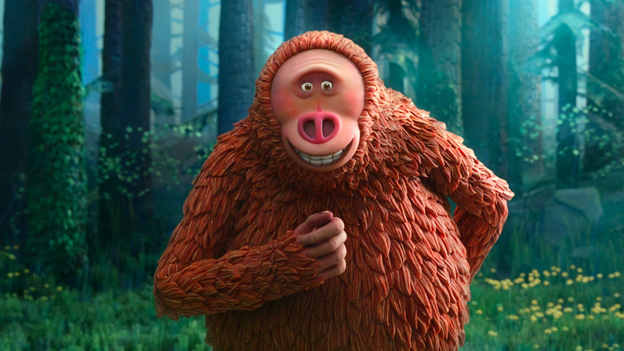 42. MISSING LINK
42. MISSING LINK
Director: Chris Butler
Laika as a studio deserves endless praise. One can always count on them to put out something wondrous that captures the eye, imagination, and heart. They are pretty much single-handedly keeping the unforgiving art of stop-motion animation alive and making it magic again. Their latest installment, MISSING LINK, is a more-than-15-year effort from director Chris Butler, previously co-director of the ingenious PARANORMAN. Hugh Jackman voices Sir Lionel Frost, a gentleman adventurer mocked by his peers but set on making the next great myth-confirming discovery. When a rare fan letter from the Pacific Northwest comes to his door claiming to know the whereabouts of a mysterious yeti-like creature, Frost sets off. The author is one Mr. Link, voiced by Zach Galifianakis, who turns out to be the yeti himself, and a quite erudite one at that. Link promises Frost an even greater discovery in requesting his help finding the rest of his kind in the lost city of Shangri La. The intricacies of the locales on their journey rival only that of every model’s movements. It’s truly a sight to behold and goes toe-to-toe with the most sophisticated of computer-generated animation technology [Alexander Larios]
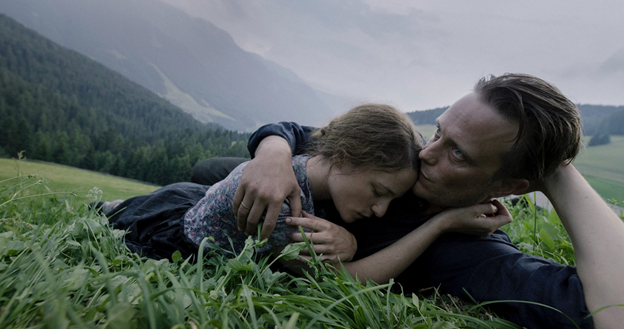 41. A HIDDEN LIFE
41. A HIDDEN LIFE
Director: Terrence Malick
It’s baffling and honestly shameful how master director Terry Malick’s latest full-length outing has received absolutely no awards love. A HIDDEN LIFE tells the true story of Austrian farmer Franz Jägerstätter, played here by August Diehl of INGLOURIOUS BASTERDS fame, who in World War II refused to swear the oath of loyalty to Hitler and was thus promptly imprisoned by the Nazis. Malick’s capturing of the beauty of pre-fascist Radegund is breathtaking, yet only once those open views are traded for prison walls is their worth truly appreciated. The portrayal of sacrifice turning Franz’s charmed farm life dream into an oppressive nightmare is marvelous. It’s hard not to feel something as Franz and his wife Franziska, played fantastically by Valerie Pachnee, hold strong all the way through. Without a doubt, A HIDDEN LIFE is a better testament to Jägerstätter’s struggle than his beatification by Pope Benedict. [Alexander Larios]
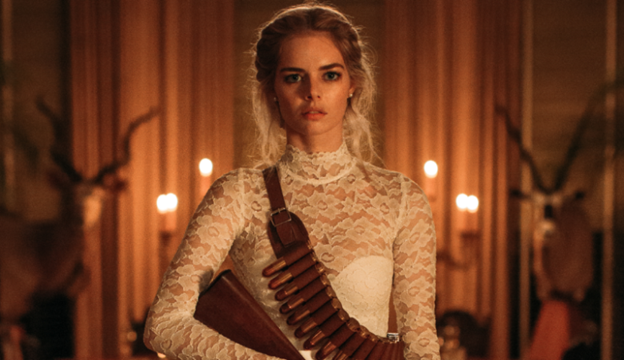 40. READY OR NOT
40. READY OR NOT
Director: Matt Bettinelli-Olpin and Tyler Gillett
A triple-billing of PARASITE, KNIVES OUT, and READY OR NOT could do the heart and spirit some good. While the former films have (justifiably) seen lots of praise, consider READY OR NOT your campy, late-night final film in the eat-the-rich trifecta, a simple chase thriller that finds hide-and-go-seek turn deadly. Samara Weaving chews scenery as the bride whose newly betrothed husband’s wealthy family are trying to kill to appease a curse—that they made their money in board games gives you a good idea the level of goofiness you’re in store for. Even if the film’s social messaging takes a back seat to its simplistic plot, it’s there, and watching an immensely rich group of idiots slowly die because of their own ineptitude remains highly entertaining. Also to Adam Brody: My guy? Where have you been? You’re great in this. Make more movies! [CJ Simonson]
 39. CRAWL
39. CRAWL
Director: Alexandre Aja
CRAWL is, admittedly, about a Mississippi half-step above a SyFy Original Movie, but that it becomes legitimately the best version of that flimsy Friday night B-Movie fun is unquestionably what makes it so endearing. Alexandre Aja delivers a sub-90-minute survival flick packed with alligators and then, for good measure, even MORE alligators. It features genuinely fun and gripping action set pieces that range from claustrophobic anxiety attacks to open water JAWS riffing, and gives the bare minimum amount of character background and motive to justify its premise. MIDSOMMAR is fine and dandy, but let’s not ignore the quality that elevates some of the best horror films ever made: Simplicity. [CJ Simonson]
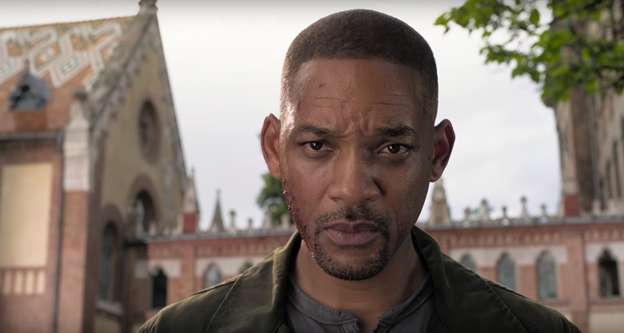 38. GEMINI MAN
38. GEMINI MAN
Director: Ang Lee
Had I not seen GEMINI MAN in its 3D, 120 fps glory, I might not harbor the affection for it that I do. After about an hour of delay in getting the nascent and innovative technology to project properly, and the boisterous and no doubt galvanizing hectoring of an older gentleman who claimed larceny due to the hiccups in the system, I was whisked away into Ang Lee’s ridiculous and rollicking experiment. Lee’s action chops are undeniable: he’s imported his focus on ontological anxiety, exemplified in the fluid masters of EAT DRINK MAN WOMAN, into the high-stakes mercenary film; the terror of these fight sequences is that we know we’re seeing real people charged at with motorcycles, without the luxury of a cut. It’s made even more trippy by the fact that one of these characters, while occupying physical space, is actually a partially-CG-composite of the actor fighting opposite him. Is it far-fetched? Maybe, though the notion of a federal agency creating genetically-modified super-soldiers sans affect to wage imperialist wars in the Middle East doesn’t seem too ludicrous to me. [Luka Stojcic]
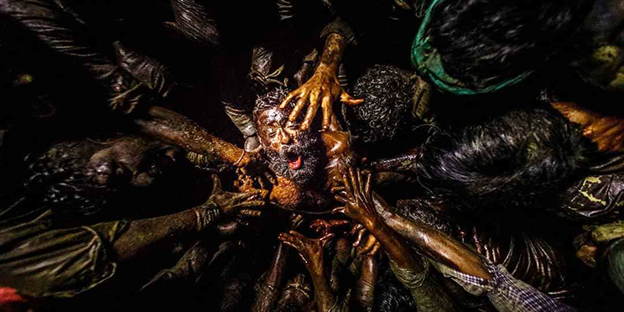 37. JALLIKATTU
37. JALLIKATTU
Director: Lijo Jose Pelliissery
As blunt as a buffalo breaking into your living room, demolishing your dining room, and escaping through your bedroom wall like it was made of tracing paper, Lijo Jose Pellissery’s JALLIKATTU harbors a simplicity that threatens to shift into tedium. It’s an entire Indian town unified by the pursuit of a wild animal on the run for its life. Exhaustingly exhilarating, but the final 20 minutes are so impressive that I think you could completely skip the preceding 75 and get the full-to-possibly-fullest experience—it is the rare modern film wherein all of its achievements are accomplished via absolute motion. JALLIKATTU is an onslaught of film movement purposefully in search of a master plan, hundreds of flashlights and torches frantically waved in the deep of night. Pellissery’s adrenaline shot moves at an unbelievable speed for its multi-terrain-trotting scope, entirely composed of gimbal-mounted footage of prehistoric creatures sprinting across rural landscapes, determining who’s the ape and who’s the monolith in the futile relationship between man and nature. It’s like MAD MAX: FURY ROAD from the perspective of Immortan Joe. [Kevin Cookman]
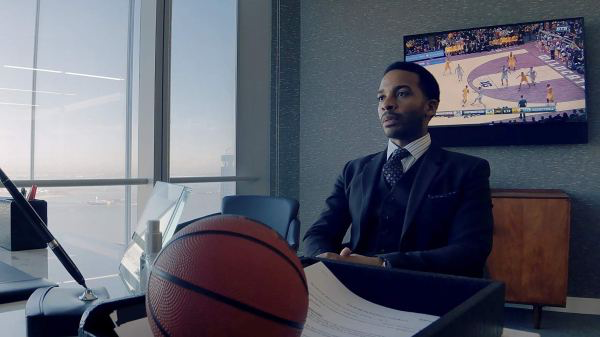 36. HIGH FLYING BIRD
36. HIGH FLYING BIRD
Director: Steven Soderbergh
A film about an NBA lockout that’s locked out a solid percentage of its potential viewers—look, I write about film for Merry-Go-Round Magazine, you think I know sports, pal? Confusing the viewer with the economic politics of a lockout is part of HIGH FLYING BIRD’s design—the film is a push to understand this shit. We the people are seen as chess pieces in a greater economic system, so we should actively work to understand the game! HIGH FLYING BIRD, while on its face a rollicking screwball picture about rotations of power, invites its viewers to research: the implications of its characters’ discoveries do not start and end with the film. A worthy follow-up to the brilliant UNSANE, the camera phone functions as an admission ticket into elite spaces, ones previously barring people of color from entrance who are now handed concessions when a larger bureau can exploit their talents for billion-dollar profit margins. Economy-class filmmaking on PJ’s with Pomeranians and their owners who move athletes around like chattel. The analogues to accessible filmmaking in the 2010s are certain to stir a debate or two. Soderbergh has reclaimed the formal excitement that defined the youthful blast of his onset, but with the sophistication of a filmmaker who’s been around the bend more than a handful of times. In a just world, we’d be talking Andre Holland for Best Actor consideration, while Jeryl Prescott would be a lock for Best Supporting Actress. For now, I’ll keep trying to talk people into giving what is quickly becoming one of Soderbergh’s most underrated pictures a shot. [Kevin Cookman]
 35. LITTLE MONSTERS
35. LITTLE MONSTERS
Director: Abe Forsythe
I’ve been using the same sales pitch since January 2019, and, buddy, I will keep using it: LITTLE MONSTERS is a broad-ass, goofy-ass, juvenile-ass throwback farce that’s Capcom’s Dead Rising meets BILLY MADISON. Making a Sundance zombie-comedy in 2019 is a death knell for interest, but Abe Forsythe’s foray veers so far into manic, prime-SNL-base hilarity that its dedication to itself is charm in and of itself. Lightning-quick, confident raunch filled with perfectly-placed screaming matches, prat-fall slapstick, and viscera-packed gore up the wazoo—it’s like ordering the most satisfying ham and swiss from your local deli. Nothing game-changing, but the exact recipe for a wonderful Saturday afternoon. Lupita Nyong’o is an actress who rarely plays a grounded character, so her portrayal of a Taylor Swift-singing kindergarten teacher is the closest we’ll get to a hang-out movie with her, a foil to the horrors of her other 2019 genre outing, US—of course, since it’s on her terms, she annihilates about four dozen of the undead along the way. [Kevin Cookman]
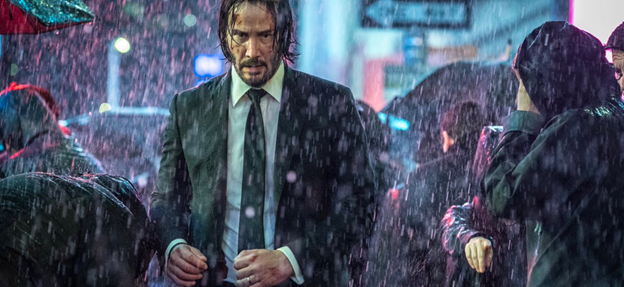 34. JOHN WICK: CHAPTER 3 — PARABELLUM
34. JOHN WICK: CHAPTER 3 — PARABELLUM
Director: Chad Stahelski
What happened in this movie again? John Wick has to cut off his pinky to square things with the assassins union or something? I couldn’t tell you—all I remember about JOHN WICK: CHAPTER 3 – PARABELLUM is more or less what I have to say about the last two: Keanu Reeves wipes out a lot of dudes and it’s pretty sick. Where the first Wick’s doggy revenge story was simple and airtight, the universe of the franchise has blown out of control to cover tomes of vague lore (how many spin-offs are we getting now?), all in the service of giving Keanu bigger and badder guys to waste. No, the beating heart of PARABELLUM isn’t the web of intrigue it’s woven around Wick, but rather the simple pleasures of watching the assassin throw an entire knife collection at some hapless goons, visiting the concierge in the middle of a hotel shootout to get a bigger gun, or sending his would-be killer through a wall by slapping a horse’s ass. With the full force of the Keanusciance filling its sails, PARABELLUM has established John Wick, the character and the franchise, as culturally iconic concepts able to go toe-to-toe with Fast & Furious in the realm of absurdist, reality-defying action spectacle. [Ed Dutcher]
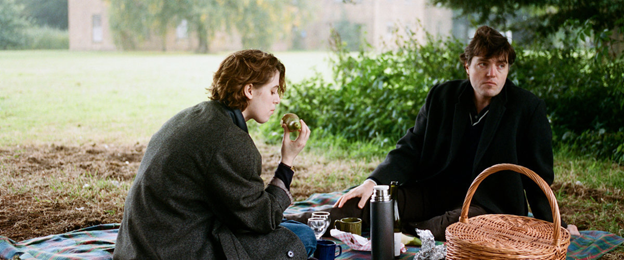 33. THE SOUVENIR
33. THE SOUVENIR
Director: Joanna Hogg
It was a curious thing that two of the most interesting pieces of art from last year used mirrors as a central image: both Angel Olsen’s exceptional album ALL MIRRORS and Joanna Hogg’s THE SOUVENIR. When closely considered, mirrors have a funny effect on us; they are a way of perceiving ourselves, and yet it’s almost impossible for those perceptions to be distorted. In this intensely autobiographical film, Hogg studies herself through an interconnecting series of mirrors, both literal and metaphorical. The result is often stomach-churning—putting your 24-year-old self under a microscope is an exercise in vulnerability I could certainly never undertake—but it is also disconcertingly beautiful. Hogg’s use of light, texture, and music is formidable, often working in mood rather than literal narrative fact. It’s also undeniable that the film’s use of sensuality and sexual tension is incredibly powerful; how Hogg chooses to portray the physicality between Honor Swinton Byrne and Tom Burke is some of the most electric filmmaking from this year. For all my minor gripes with the film, it’s also undeniable that it has several points that simply make the stomach drop. Loving an addict, and all the confusion and heartbreak that comes with it, is never an easy thing to reconcile, and to really look at yourself in such a precarious moment is an act of real courage. [Carter Moon]
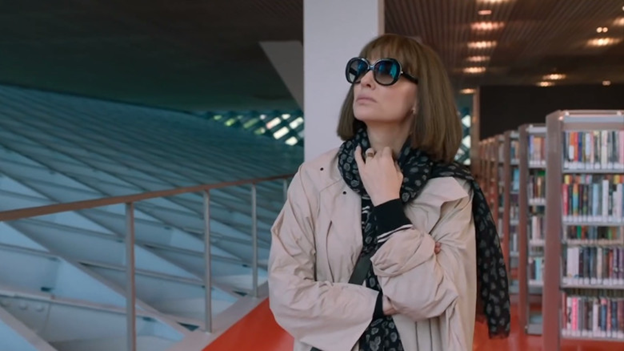 32. WHERE’D YOU GO, BERNADETTE?
32. WHERE’D YOU GO, BERNADETTE?
Director: Richard Linklater
WHERE’D YOU GO, BERNADETTE? may falter in its third act, arrested by an uncharacteristically maudlin sensibility from Linklater, but its first half is as assured as the director’s other work, seriously dark and funny—nothing like what the cheesy trailer promised us. The spectre of prescription medication is never not an amusing subject, and the script’s specificity in detailing Bernadette’s preferred cocktail is particularly winning. Linklater is one of the great American directors, let alone one of the greats working today: Bernadette’s mania is treated with ambivalence, where another director would invest it with a sensationalism which would overtake the character’s actual suffering. Blanchette may be a little precious in the role, but she’s certainly capable—it’s fine work. Confidence is not inherently a virtue in a director, but when that confidence is in the ability to create plausible characters and not arch setpieces or overwrought spectacle… That’s when you know you’re in good hands. [Luka Stojcic]
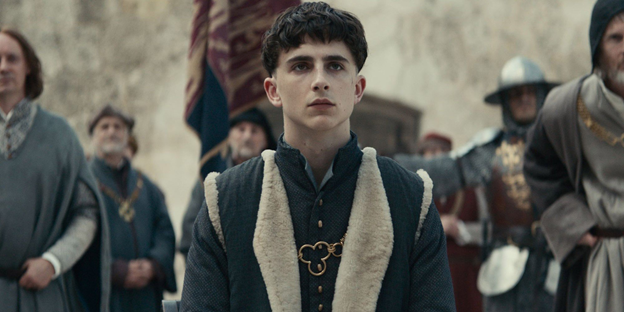 31. THE KING
31. THE KING
Director: David Michôd
The Battle of Agincourt was a turning point for the English in the Hundred Years’ War, and Henry V’s use of massed archers to decimate French cavalry was historical for forever establishing the dominance of ranged weaponry on the battlefield. This pivotal aspect of the conflict is largely glossed over in THE KING’s climactic depiction of the day that cemented Henry as a great leader, but it is also one of the least egregious gaffs in a movie that posits Timothée Chalamet could beat Robert Pattinson in a fight, let alone scores of armored knights. As outrageous premises go, however, this one is sold very convincingly by Chalamet’s brilliant portrayal of the young monarch. THE KING’s Henry simmers with the angst of having the crown foisted upon him by a father who neglected him and a ruler who neglected his domain. David Michôd’s brooding screenplay manages to balance a medieval coming-of-age with a very relatable theme of shouldering the previous generation’s mistakes, both of which Chalamet flies with in a barely-concealed whirlwind of rage. 2019 was a banner year for the star, but THE KING is the stage where the actor gave his most absorbing performance. [Ed Dutcher]
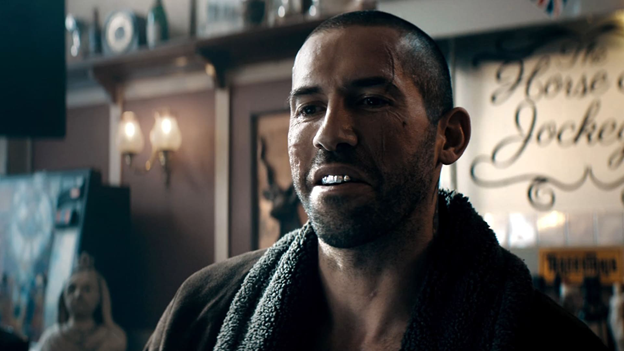 30. AVENGEMENT
30. AVENGEMENT
Director: Jesse V. Johnson
An evening at the Gallagher estate: two brothers at each other’s throats over a pint and a lot of broken glass. I really mean it when I say that AVENGEMENT goes hard. So hard that it invented a word for its title and just ran with it. It’s a no-fucks-given rodeo. The heavyweight brute intensity of S.Craig Zahler’s BRAWL IN CELL BLOCK 99 blended with the let’s-skip-the-talking momentum of a John Wick film. The fact that this is off to the races so quickly is honestly its greatest accomplishment. It’s a huge testament to director Jesse V. Johnson to watch a film so acutely aware of what its audience is here to see. There’s no justice in this world when AVENGEMENT is shelved to being an Amazon rental and KINGSMAN litters the multiplexes, but I’m kind of proud of being a part of this secret club now. Here’s to hoping this gains cult-status traction over the years! Mark my words, AVENGEMENT is a quintessential pub movie. [Sergio Zaciu]
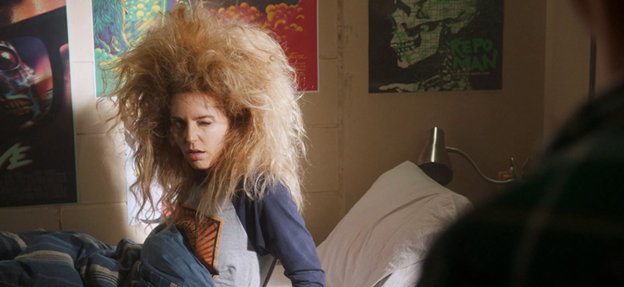 29. HAPPY DEATH DAY 2 U
29. HAPPY DEATH DAY 2 U
Director: Christopher Landon
There’s no need to attribute any textual weight to the HAPPY DEATH DAY series. The first one is a lot of fun and the second one is just as fun. Jessica Roth is a revelation as Tree: alive and urgent and witty, in a way reminiscent of Jamie Lee Curtis’ turns in the best Halloween movies. What’s also great about HDD2U is its ability to juggle a delicious sense of humor with the very real consequences of Tree’s possible failures. Like the first entry, we’re involved in watching Tree process the trauma of her mother’s death. Sure, the material in HDD2U may negate the impact of the revelations achieved in HDD, but it’s a small price to pay for getting to hang around these idiosyncratic characters once more. This stuff gets fairly brutal—a central plot point involves Tree’s incessant suicides (she needs to die to reset the day), but it’s all really funny, and not to mention harmless: treating suicide as a need rather than a desire is a great way to circumvent the potential pitfalls of a glib treatment of the subject. It’s a blast. [Luka Stojcic]
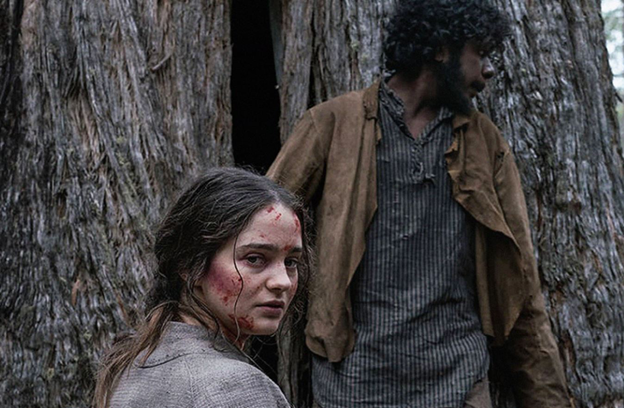 28. THE NIGHTINGALE
28. THE NIGHTINGALE
Director: Jennifer Kent
A reclamation of trauma inflicted upon women by male directors since the dawn of the moving image, Jennifer Kent’s grueling rape-revenge odyssey, THE NIGHTINGALE, takes no prisoners, especially English ones. Set in the labyrinthine trees of Tasmania, the locale and entrapped academy aspect ratio promise zero escape from Kent’s recreation of systemic abuse. She expresses the pillaging of native lands through the rape and usage of women’s bodies, offering a nightmarish, utterly unforgiving descent into the pits of men’s souls; these filthy brutes on a campaign of extermination justified and dutifully enforced by executive decree. Don’t look away. Your forefathers committed these crimes. Your foremothers sat and watched. THE NIGHTINGALE is 1974 primal horror, really the best movie Wes Craven never made, but with the technical precision capable via modern technology and a century’s worth of genre know-how. Aisling Franciosi is a stone-cold powerhouse, her eyes capable of maintaining the most magnetic of gazes and the most cavernous displays of desolation. She’s got nothing to lose but the successful collection of her rapists’ heads on wooden spikes. Viewer beware: Jennifer Kent returned with one of the best films of 2019, but also one of the most bleak and punishing films I’ve ever seen. [Kevin Cookman]
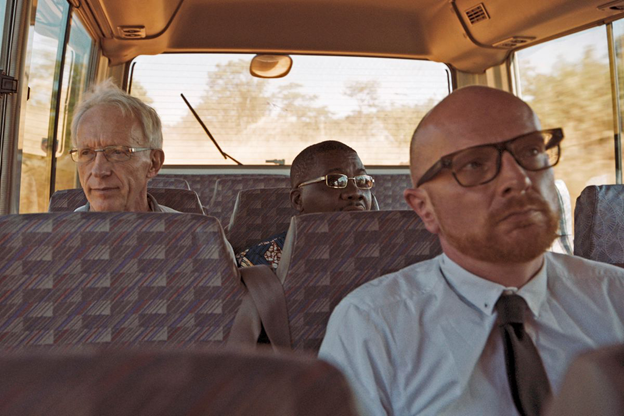 27. COLD CASE HAMMERSKJÖLD
27. COLD CASE HAMMERSKJÖLD
Director: Mads Brügger
Decades after trolling North Korea to their faces and impersonating a diamond-smuggling ambassador in the Central African Republic (just to prove that he could), documentary daredevil Mads Brügger returns with more humble, perhaps beneficiary motives. A murder-mystery whodunnit that appears tame (the fishy plane crash demise of Dag Hammarskjöld, the former Secretary-General of the United Nations) unspools into the director’s finest synthesis of outlandish manipulations and shocking factuality. The story turns so ghastly that even Brügger realizes that his sense of humor has been misplaced: he’s in over his head. His transparency, and willingness to heartlessly self-efface, is so refreshing—without losing track of its goals as a piece of investigative journalism, COLD CASE HAMMARSKJÖLD’s format matches the ebbing flows of the documentarian’s decision-making process. Seeing as a crime against humanity is unveiled by jumping through nonsensical hoops, Brügger argues in favor of the art of the tangent. To attain higher truths, we must venture outside the borders of conventional knowledge. [Kevin Cookman]
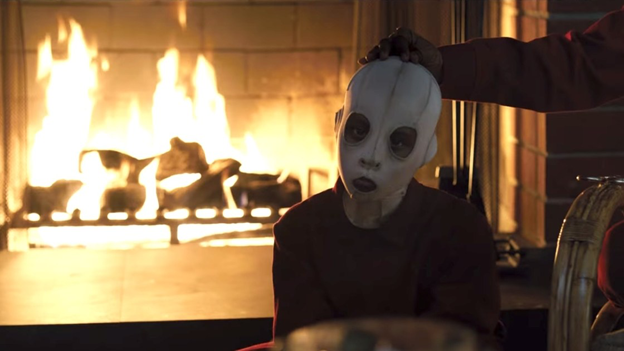 26. US
26. US
Director: Jordan Peele
As is the general going rate around these parts, GET OUT was a cultural juggernaut that firmly established Jordan Peele as one of modern filmmaking’s most powerful and resonant voices. As such, there was certainly some trepidation during the build-up to US due to his debut being a hard act to follow, but while perhaps lacking its predecessor’s sense of knife-sharp anger and critique, Peele’s second time around the merry-go-round went bigger, bolder, and much, much more bizarre. As far as I’m concerned, what’s most endearing about US is the fact that the Tethered and their Arms Across America are one of the more striking examples of the “weird” elements of classic genre throwbacks, feeling like a general premise that could have appeared in a gory ‘50s comic book you’d keep hidden under your bed, albeit suped-up to have a more directly and distinctly relevant modern racial commentary. Augmented with a surprisingly light touch that continually makes sure to not skimp out on the comedy, a garden variety of striking visuals and “gotcha” moments, and a stirring performance from Lupita Nyong’o, US was perhaps not the “elevated” outing it was pitched as, but was certainly a higher class of pulp-friendly delights that 2019 was lucky to have. [Thomas Seraydarian]
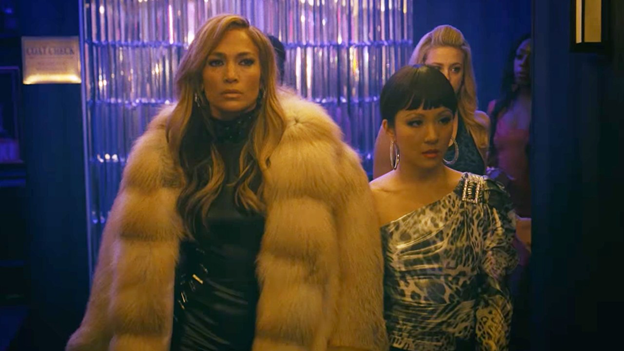 25. HUSTLERS
25. HUSTLERS
Director: Lorene Scafaria
HUSTLERS rules. Engaging from start to finish, a commentary on capitalism and how it takes advantage of those ever at its mercy, all dressed up as a sexy thriller. Director Lorene Scafaria takes a topic that could so easily be minimized and overly sexualized and treats it as seriously as any 20th century gangster film. Another shining example of the combined strength of women who are Sick Of This Shit, the relationship between Ramona and Destiny is so tender that the finale hurts in all kinds of areas. Which brings us to Ramona. Ramona, Ramona, Ramona. The finest example this century of an A-list celebrity harnessing their star power to deliver a career-defining performance. No one could sell this role like Mizz JLo, Jennifer Lopez—no other celebrity in the 21st century could pitch a denim bathing suit and make me think, “I mean yeah, why not?” She is everything. HUSTLERS hinges on the fact that Ramona could charm a man into funding her Manhattan penthouse, and with one flash of Lopez’s glossy nude lip smile you’re sold. That, and the most iconic entrance since… who can even say. The real Criminal here? The Academy Of Motion Picture Arts And Sciences. Y’all know what you did. HUSTLERS has it all: Julia Stiles, Usher, and the best use of “Royals” by Lorde. Long live female antiheroes, long live HUSTLERS. [Aya Lehman]
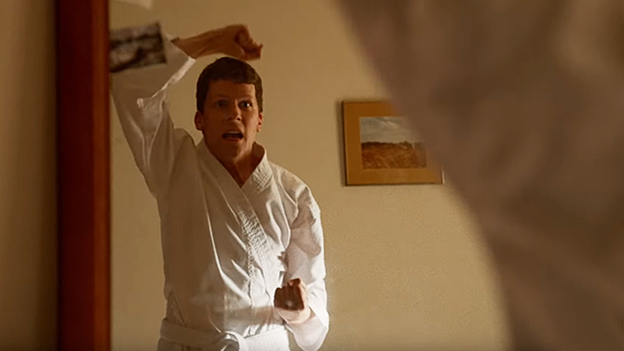 24. THE ART OF SELF-DEFENSE
24. THE ART OF SELF-DEFENSE
Director: Riley Stearns
The indie dark comedy to end indie dark comedies, Riley Stearns’ THE ART OF SELF-DEFENSE is a queasy tonal hodgepodge that’s admittedly not for everyone, but any detractors are missing out on something special. Tracking with the timid doormat Casey Davies (played by an absolutely pitch-perfect Jesse Eisenberg) as he becomes progressively more involved in a karate dōjō after suffering an attack from a motorcycle gang, saying that Stearns keeps us on our toes is the understatement of the year. Continually unsure whether we’ll be exposed to an acid-smart dose of gut-busting black humor, an interaction so meticulously awkward we’ll want to chew through our own jaw, or a shocking bout of gruesome violence that will have the stomach heaving, Stearns maintains a masterful sense of control over the course of the proceedings. While there’s certainly a place for the red-button thematic alarmism that many of the film’s peers demonstrated over the course of 2019, THE ART OF SELF-DEFENSE is far more reserved and clever than many give it credit for, an intricate sense of irony continually operating in the background, reaching a fresh conclusion that posits that “becoming a man” is all about failing upward. [Thomas Seraydarian]
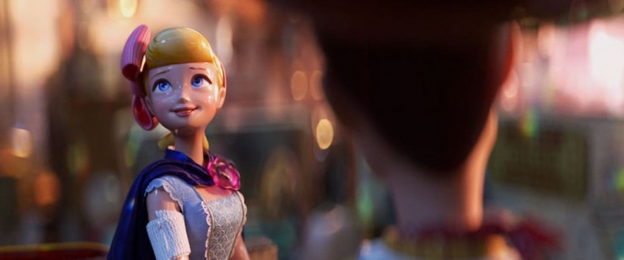 23. TOY STORY 4
23. TOY STORY 4
Director: Josh Cooley
Sure, TOY STORY 4 is a wholly unnecessary side story, but it sure has enough heart to earn its place as a legit numbered sequel. That longing for a sense of purpose, established by the very first film, remains as strong a throughline as ever in the franchise. After Andy’s bequeathing of the toys to Bonnie, natural leader Woody is sidelined once again as Bonnie’s preference lands on Jesse. The baby toys she has outgrown offer words of encouragement but Woody, having already learned this lesson years ago, finds his new role in protecting and mentoring a creation of Bonnie’s: Forky. The sentient spork’s screen time is surprisingly minimal despite being voiced by the hilarious Tony Hale of ARRESTED DEVELOPMENT fame. As his desire to be in the trash separates him and Woody from the rest of the group, Forky provides, if not a children’s guide on existentialism, a good reflecting point for Woody while he recalls the past and considers a possible future without a kid. Annie Potts’ return as Bo Peep pulls him in that direction as he sees his long-lost love now turned fiercely independent. It’s no secret why this is written mostly in Woody’s perspective. TOY STORY 4 focuses much more on the toys and their thoughts and desires rather than that of their human counterparts. It’s an interesting turn that those who grew up with the films, now adults with real problems, can deeply appreciate. And I haven’t even got to the absolutely stellar animation, Easter eggs for toon heads, and Keanu Reeves as Duke Caboom! [Alexander Larios]
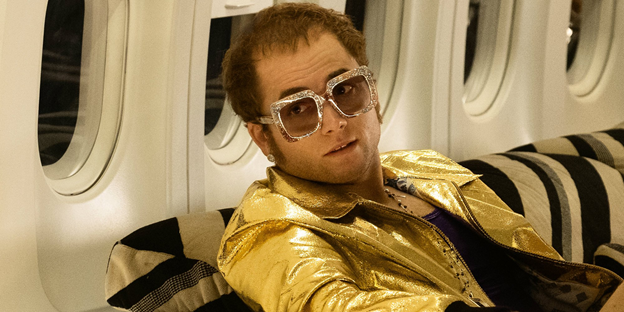 22. ROCKETMAN
22. ROCKETMAN
Director: Dexter Fletcher
Music biopics are a dime-a-dozen, the average filmgoer expecting at least one a year. For many, there is something satisfying about the usual rags-to-riches and/or falling-from-grace tale that these typically turn out to be. We love a good true story, and we can’t deny our eagerness to see the lead actor completely disappear into a role, regardless of whether they actually know how to sing or play an instrument. But ROCKETMAN refused to follow its predecessors and it paid off. Telling the story of the life of Elton John through surreal musical numbers of his best-known songs, this film pushes boundaries by taking the songs out of the recording studio and off the stage at multiple occasions. While it was a risky choice to make this a musical with fantasy elements, looking back on this film, nothing could have worked better for telling the story of Elton John’s musical, fantastical life. The fact that the real Elton John is alive and thriving helps immensely, as he was able to guide how his own story is told, proving that perhaps sometimes it’s good to let the subject have most of the creative control. ROCKETMAN is aware of its own melodrama but manages to remain overwhelmingly honest despite its spectacle, and remains fun and captivating for even those who don’t know a thing about Sir Elton. [Nadia Hayford]
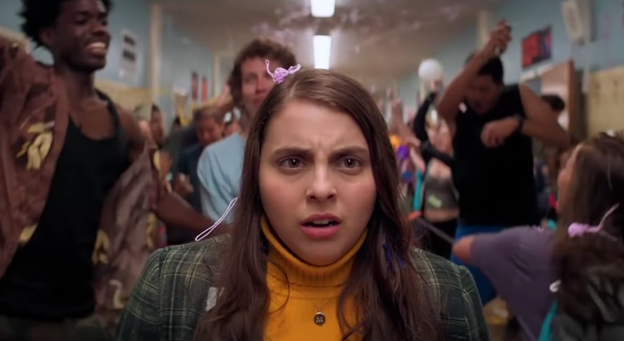
21. BOOKSMART
Director: Olivia Wilde
THANK MARY MAGDALENE IN HER FABLETICS for female friendship, moreover art that centralizes and showcases the nuances of female friendship, albeit the fact that the friendship depicted in Olivia Wilde’s directorial debut BOOKSMART is one in a long list about two middle-class, white women. Although, there is still a distinguishing factor for movies like BOOKSMART or the similar FRANCES HA: earnestness. With one of the most relatable film premises of the decade, BOOKSMART grapples with the inevitable post-high school ideology: “Have I wasted my youth?” and “Am I fuckable?” The best friends’ irreverent humor and the social commentary on women’s presentation in the Barbie scene makes it SUPERBAD with a purpose. For a film that seems so eccentric, loose, and absolutely bonkers, it’s one of the most carefully curated, clever depictions of growing up to come out in a long time. AAA telling Molly that “the girls slut shame her just as much as the guys” is a small line that packs a massive punch; in high school, tearing down other women is one of the easiest things to do and the hardest to reflect on. Plus, poignancy of narrative aside, the soundtrack is divine—whoever picked not one, but two Perfume Genius songs deserves a medal of honor—and the pool scene is some of the most gorgeous cinematography I’ve seen in any film. The reason BOOKSMART was such an unexpected cultural smash hit is because the women behind it made sure to make the audience give a shit. Watch BOOKSMART and tell your friends how grateful you are to have them in your life. That’s an order. [Jesse Herb]
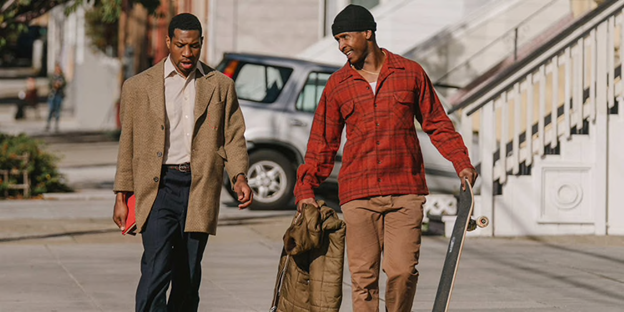 20. THE LAST BLACK MAN IN SAN FRANCISCO
20. THE LAST BLACK MAN IN SAN FRANCISCO
Director: Joe Talbot
Director Joe Talbot came out of nowhere with his incredible feature debut, starring and based on the life of his best friend Jimmie Fails. THE LAST BLACK MAN IN SAN FRANCISCO is about many things—the way neglect and gentrification destroys communities of color, the value of close friendships, and processing loss, among others. But to put it simply, this film is about San Francisco, in what’s quite possibly the most intimate hometown love letter I’ve seen. Shot like a painting from the Romantic era with a beautiful classical score, it feels like something out of a dream. With a cast of mostly non-actors native to the neighborhood in which it was shot and set, the film stays grounded and lacks any pretension. It’s refreshing to see something that feels like high art remain accessible for everyone. I pray to the film gods to bring more gems like this to the screen. [Nadia Hayford]
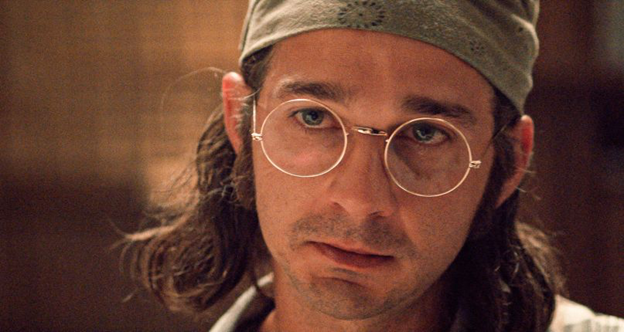 19. HONEY BOY
19. HONEY BOY
Director: Alma Har’el
What is the point of acting, why do we pay people to do it, and what does good acting entail? How do we know when a performance feels authentic? It’s a very weird urge we have, to watch human beings pantomime as other human beings while speaking words they usually didn’t write themselves. Shia LaBeouf put the notion of what acting can accomplish to the ultimate test with HONEY BOY, starring in the film as his own father as he reenacted painful childhood memories with Noah Jupe playing LaBeouf as a child. The effect is uncanny and unshakeable, LaBeouf brings a spirit of resentment, fear, and passion to his father that feels almost too real. As the narrative unfolds, it becomes apparent that LaBeouf needed to make this film as an act of personal exorcism, a casting-out of childhood demons which he has no other way to rid himself of. Under the artful direction of Alma Har’el, HONEY BOY becomes a tender portrait of intergenerational pain, not just a dynamite acting exercise but also a moving examination of the ties that bind us. LaBeouf may be complicated and controversial as a public figure, but with HONEY BOY it became undeniable that his dedication to his craft pushes him to places few actors would ever let themselves go. [Carter Moon]
 18. DOLEMITE IS MY NAME
18. DOLEMITE IS MY NAME
Director: Craig Brewer
Given how much Hollywood loves both movies about making movies and underdog narratives, be it for the real-life actors or the on-screen characters or, in this case, both, it’s kind of shocking that DOLEMITE IS MY NAME didn’t see more of an awards splash this Oscar season. And if everything stated in this previous sentence gives you pause, don’t worry, you’d traditionally be right to be wary of Netflix’s Rudy Ray Moore story. And yet at the core of the Eddie Murphy comeback vehicle is an unbridled amount of joy, which feels rare for something that reads as far more clinical and paint-by-numbers than it actually appears on screen. Perhaps in many ways because the DIY lessons at the core of the film feel particularly pressing, or that the issues of representation in Hollywood continue to be an industry-wide epidemic all these years later, DOLEMITE IS MY NAME feels uniquely current, a celebration of things that we should strive to be without a hint of cynicism. That the film lands laughs with an excellent Murphy performance make it more than just your run-of-the-mill biopic. [CJ Simonson]
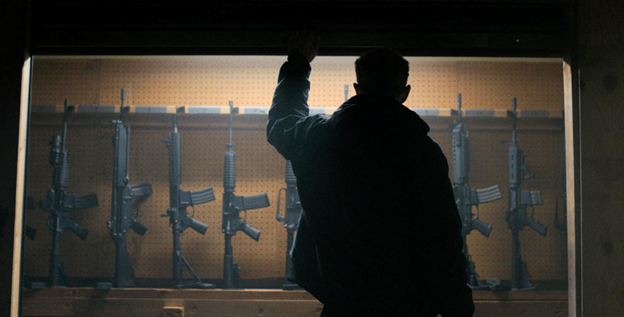 17. THE STANDOFF AT SPARROW CREEK
17. THE STANDOFF AT SPARROW CREEK
Director: Henry Dunham
Possibly the best film of 2019 you haven’t heard of, Henry Dunham’s debut was quietly released in the first weeks of January after a September ‘18 festival run, relegated to a non-descript appearance on Amazon Video shortly afterwards. It’s a shame, because THE STANDOFF AT SPARROW CREEK easily holds its weight against last year’s indie hitters, a confident and contained statement that makes it clear that screenwriting, screenwriting, and screenwriting once again is still the most important aspect of the artform. Tracking with a group of backwoods militia types as they discover that one of the guns in their armament is missing, ostensibly used in the shooting-up of a nearby police funeral, Dunham sticks to the old adage of putting your characters in the worst situation possible at any given moment. It redefines moral ambiguity, giving even the most deplorable members of the militia backstories sympathetic enough to suggest that perhaps the true villains will always be those who choose to hide behind a badge. THE STANDOFF AT SPARROW CREEK is lean, mean, and as explosive as the much-debated stock of the arsenal, and is easily one of last year’s best-kept secrets. [Thomas Seraydarian]
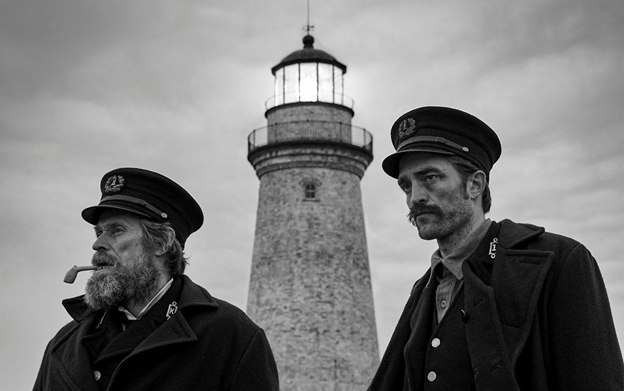 16. THE LIGHTHOUSE
16. THE LIGHTHOUSE
Director: Robert Eggers
For those of you who saw this film as a “pretty Pinterest page of ideas, but not much execution,” or something alike, know that I see you, hear you, and you’re valid but I also can’t fucking stand you. Robert Eggers, master of the ethnographic narrative, explores the dark and implicitly perturbed lives of lighthouse “wickies” in the early 20th century with his black comedy, THE LIGHTHOUSE. As we all know, it’s incredibly difficult to do comedy; just because HOT ROD (2007) does it with gorgeous ease doesn’t mean it’s the norm. Black comedy even moreso, yet Eggers manages to find it and blend it seamlessly with undertones of horror, spiraling into John Carpenter-esque madness. The juxtaposition of macabre imagery and dialogue like “So yer a fan of me lobster ain’t ye?” is far beyond well done: it’s genius. Not to mention, all of these notions are against the backdrop of an aspect ratio that reconstitutes the film’s claustrophobia and plays out like a haunting series of daguerreotypes. Eggers makes it abundantly clear that the devil is in the details. Plus, everything that’s been relentlessly harped on are only the superficial, visual aspects of the film. The narrative itself is one of the most harrowing portrayals of two men so overcome by their own grief that it’s only a matter of time, and a perfect storm, before they have to finally cope with their actions. Dafoe is a deadbeat father who killed his second-in-command, while Pattinson is on the lam for killing someone at his previous job. The only solace either of them have is the promise of glaring at a light so bright it can temporarily wash away any of their grievances. I’m getting chills just thinking about it. THE LIGHTHOUSE has all of this and a whole shot devoted to RPatz’s muscled ass, need I say more? [Jesse Herb]
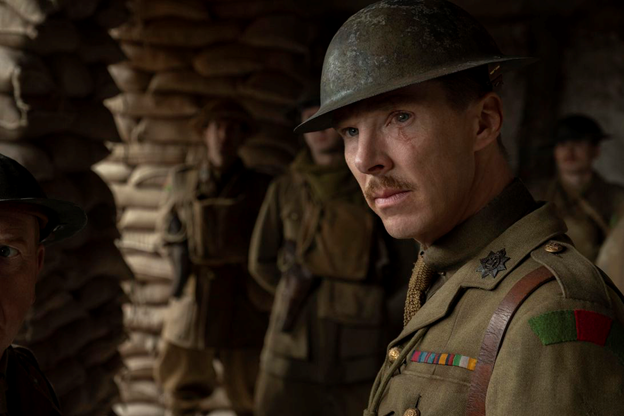 15. 1917
15. 1917
Director: Sam Mendes
Where DUNKIRK (the most obvious, though reductive, comparison point in recent cinema) is an impressionist painting, 1917 is a grand mural, linear to a fault as your eye traces the action from left to right continuously for two hours, with the glorified cameos of Colin Firth and Benedict Cumberbatch serving as thespian bookends. Both films succeed in being so cinematic that I’d have a hard time re-watching them at home, and both succeed not so much in convincing me of the tired trope that “war is Hell,” but of simply putting me in the middle of that Hellish warzone on a 2D screen in a way that fulfills the promise of Virtual Reality. For the sake of utter immersion, the film combines the best parts of cinema, video games, and theatre, and while it isn’t perfect from start to finish, the story about as simple as AVATAR’s, no other experience in the theater this year put me on the edge of my seat more as I came closer to a coronary. I will never forget the electric jolts to my spinal cord starting with a simple prick of the finger on barbed wire, and ending with a pulse-pounding climax across the battlefield, where Thomas Newman’s score arguably instills more emotion than even Hans Zimmer’s ticking watch in DUNKIRK. See it in a theater, or not at all. [Reid Antin]
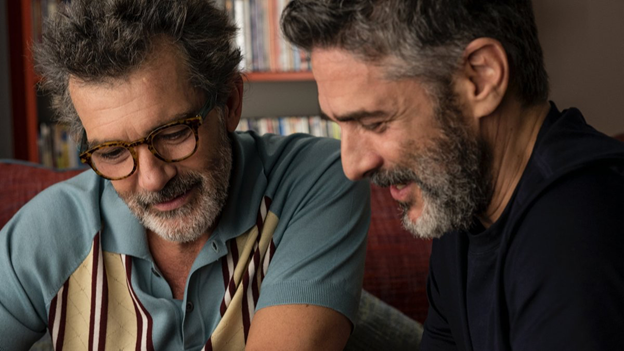 14. PAIN & GLORY
14. PAIN & GLORY
Director: Pedro Almodóvar
Almodóvar’s critique of the Marvel movies is surely the preeminent in the whole discourse: they are completely and utterly sexless. Almodóvar’s oeuvre, on the other hand, is a full-throated embrace of human sexuality; every one of his films, like the great Luis Buñuel’s, is informed by the unquenchable desire inherent in each of us. PAIN & GLORY seems a response to the mass erasure of sexuality in modern (or, at least, American) cinema. That’s not to say there are depictions of graphic intercourse in the film: there aren’t. What is omnipresent in PAIN & GLORY is the tinge of regret, the feeling of dissatisfaction that accompanies the ongoing journey of sexuality. The characters in PAIN & GLORY are kept in check by their environment, like we all are; it is this awareness of material conditions, societal structures on a subject’s neurosis that makes Almodóvar’s films so special. Antonio Banderas is gut-wrenching, almost impossibly brave and vulnerable as Almodóvar’s self-insert character. Desire takes everything from us, and it’s all we have. [Luka Stojcic]
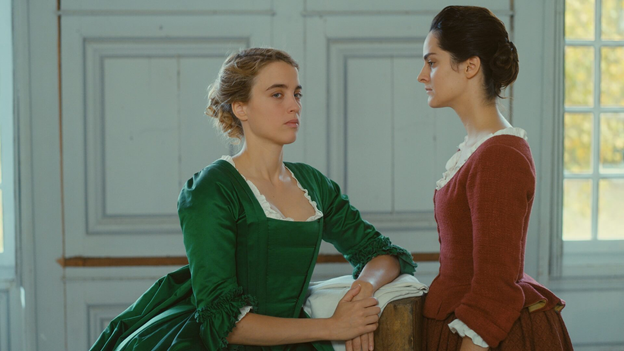 13. PORTRAIT OF A LADY ON FIRE
13. PORTRAIT OF A LADY ON FIRE
Director: Céline Sciamma
There’s just no polite way to put it—PORTRAIT OF A LADY ON FIRE (2019) had me absolutely feral. Sometimes you watch a movie and you feel this sensation tingling in your fingertips that overcomes you with a desire to tear your eyes out, to dig your nails into your palm so hard that you gush blood all over the Arclight Hollywood seats. There are at least 10 scenes in PORTRAIT OF A LADY ON FIRE that inspire this feeling. A portrait of a passionate love, of womanhood, of the relationships that shape us forever, PORTRAIT awakens the senses in a way that few films can. In a landscape of cinema as more of a business and less of an art, it’s endlessly breathtaking to see a movie that could easily hang in the Louvre—a film about queer women no less. Queer women who (spoiler alert) don’t die at the end. It’s a fairytale, a love that engulfs you in flames and singes the ends of your skirt every time you see the number 28. There’s almost no better depiction of the way a person can haunt you, the way a memory can be sweeter than the thing itself, as a memory never has to end. Like the romance at its center, PORTRAIT OF A LADY ON FIRE almost feels too good to be true, too beautiful to be real. [Aya Lehman]
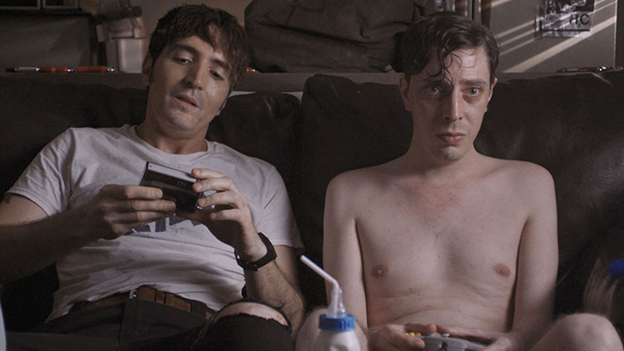 12. RELAXER
12. RELAXER
Director: Joel Potrykus
Joel Potrykus’ films just hit different. The delirium and ever-escalating stakes of RELAXER would be impressive in any film, but for a narrative that limits itself strictly to a couch, Potrykus pulls off a Herculean feat by making his movie endlessly entertaining, bursting at the seams of its self-imposed constraints. Potrykus has always had a love of blending high-brow and low-brow cinema while remaining dirty and DIY, and RELAXER feels like his next evolutionary step as a filmmaker. The film is undeniably gross and weird, but it’s also rife with commentary on the stupidity of men, particularly men who feel completely disposed from ever taking any control over their circumstances. It’s not a critique of toxic masculinity so much as an honest exploration of why men torture each other and themselves for literally no reason. Of course, Joel would never admit to any such lofty ideals; if you check out my interview with him from last year, you’ll see that he’s wary to cop to big analytical frameworks behind his films. Ultimately, that’s kind of the magic of his work, and especially of RELAXER. The lack of pretension in favor of just being funny and genuine makes it all the more effective. [Carter Moon]
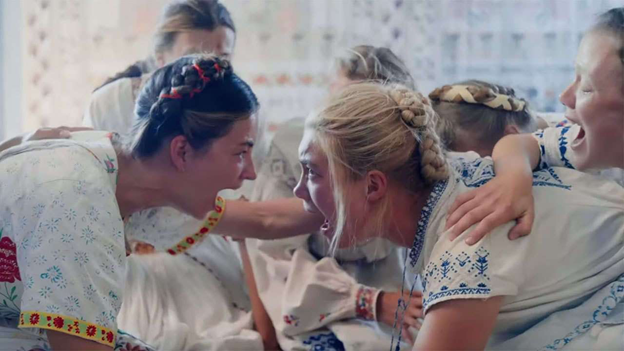 11. MIDSOMMAR
11. MIDSOMMAR
Director: Ari Aster
Love it or hate it, it’s hard to argue that A24 didn’t do a lot to change pop culture’s overall acceptance and enjoyment of the horror genre over the course of the 2010s, due in no small part to Ari Aster’s debut feature, HEREDITARY. The face that launched a thousand think pieces on “elevated horror” and its validity, I’m of the minority that finds his sinister, Swede-heavy follow-up the superior outing. One of the few genre epics to earn its extended length, steadily increasing tension and our investment in the characters in equal measure throughout, MIDSOMMAR will always stick with me for the way it envelops you in its world of story. But what’s most important about MIDSOMMAR is that there is something beautiful contained within, a film that finds catharsis in the extreme and compassion in violence against those who have held you back. It was something fresh, it was something captivating, and it was something that brought Florence Pugh to the front of the cultural consciousness. What’s not to love? [Thomas Seraydarian]
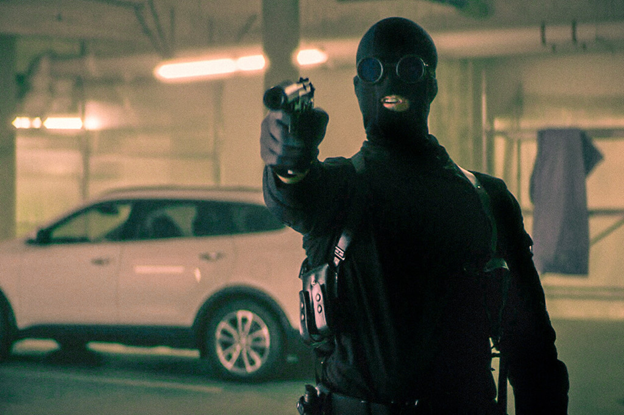 10. DRAGGED ACROSS CONCRETE
10. DRAGGED ACROSS CONCRETE
Director: S. Craig Zahler
Perhaps no other film in 2019 was as loudly celebrated by its ultra-niche fanbase and as undeservedly shelved as DRAGGED ACROSS CONCRETE, S. Craig Zahler’s third installment in a defiant oeuvre of brutal pulp. We’ve sung the praises of BRAWL IN CELL BLOCK 99 quite a bit here, and those familiar with his debut film, BONE TOMAHAWK, are no strangers to his bullish charms, but DRAGGED ACROSS CONCRETE registers as Zahler at his most auteurist—his camera stylo confidently walking the slow-cinema tightrope of a real-time heist film and an ultra-tactical shoot ‘em up. I have so many things to say about DRAGGED ACROSS CONCRETE, from the bold decision to cast Mel Gibson and Vince Vaughn as racist cops, to the ruthless portrayal of white supremacist terror. Unfortunately, the majority of the film’s discourse has been clouded by headline-savvy talking points about Zahler’s politics, but what helps DRAGGED ACROSS CONCRETE stand out in a decade so cluttered with black-and-white discussions of race, age, and culture is its willingness to drudge through the murky greywaters of our social swampland, whether we like what it has to say or not. [Sergio Zaciu]
 9. MARRIAGE STORY
9. MARRIAGE STORY
Director: Noah Baumbach
Divorce affects nearly all of us in one way or another throughout our lives, and often from the outside in, it’s hard to comprehend how seemingly happy couples manage to call it quits. What’s great about MARRIAGE STORY is that it doesn’t force us to pick a side. It doesn’t try for cheap laughs at the couple’s conflicts or worse, forced tears at their pain. It tells it like it is at every turn, pulling back the curtain on the legal circus that a divorce can become when lawyers get involved, and reminding us of the millions of little factors that can cause a relationship to break down. As is typical with Baumbach films, the actors are given a lot to do and the audience is given a lot to unpack. You leave the film feeling as though somehow you’ve physically walked with the characters on their path towards their next chapter. A concept so simple and common in our lives could have been difficult to make unique and captivating, but MARRIAGE STORY pulls it off as a masterpiece of subtleties. [Nadia Hayford]
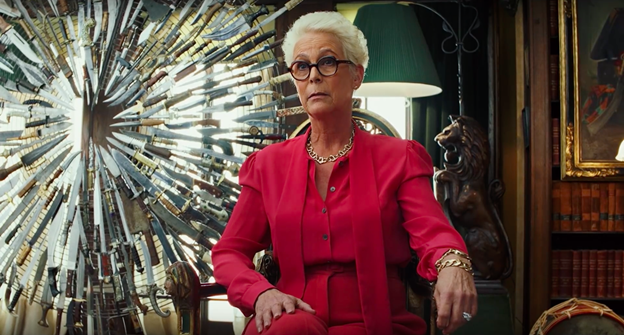 8. KNIVES OUT
8. KNIVES OUT
Director: Rian Johnson
There is more than something to be said for passion projects as a whole, but especially in 2019. Critically acclaimed or nationally disdained director, depending on what part of his filmography you harp on, Rian Johnson returns to his bread and butter with KNIVES OUT. Seamlessly blending the present-day cultural lexicon while also retaining as much camp as 1985’s CLUE or the 1978 adaptation of DEATH ON THE NILE, Johnson’s latest is a romp. A star-studded cast of veterans, from Christopher Plummer and Jamie Lee Curtis to promising newcomers Ana De Armas and Katherine Langford, remind us of an important notion often forgotten; it’s ok to have fun in film! Whether it be the saturated opulence dripping in every shot of that mansion, Daniel Craig’s deep Southern drawl, or the innovative metric of how this mystery is solved, the euphoria radiating from all involved is palpable. What is perhaps most impressive, though, is KNIVES OUT’s undercurrent of American xenophobia. Similar to Jordan Peele’s GET OUT, an absurdly wealthy family is insistent on the ally theater of it all. Of course Peele and Johnson had very different tones for their films, but the mirroring is insightful and perpetuates refreshing visibility. If you’re like me, aka thinking Rian Johnson peaked with BRICK (2005), you and I couldn’t have been more wrong. [Jesse Herb]
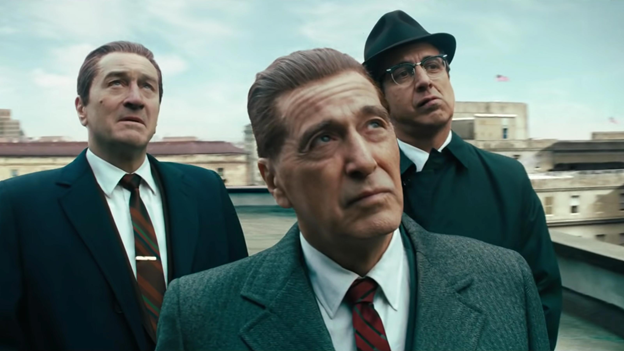 7. THE IRISHMAN
7. THE IRISHMAN
Director: Martin Scorsese
Multiple timelines converge into one, where the day’s minutes trickle like sap. Watching your most loyal sink into graves and feeling the thunk of every shoveled clump of dirt. The jukebox selections are down a few decibels. Instead, there’s the airy background music as you cross your ankles on a Sunday morning. The pomp of steak dinners and vintage wines is nothing compared to ice cream sundaes and chili dogs, but the established social geography of a dimly lit restaurant-bar is sacred. GOODFELLAS is the manic downward spiral built into the blueprint of the made life, but THE IRISH—ah, who am I kidding, I HEARD YOU PAINT HOUSES depicts a lumbering death march. Robbie Robertson’s musical theme of snares and spacious harmonicas establish the scene for a late-period western set in the background of the crumbling American empire, where hundreds of old guns lay at the bottom of the Schuylkill River. Twilight-year Scorsese is quite the beast. He’s just as equipped for style as he was with the fresh regret of coke-coated nostrils, but it’s the greater idea that interests him: soft audio design, inconsistent match cuts, and poor audio lip syncing be damned! Pesci’s the easy highlight until it’s Ray Romano, but then it’s far and away Pacino, then maybe just maybe Anna Paquin, then without a doubt Louis Cancelmi, and then maybe the best performance of an entire career in De Niro. They all trust Scorsese so deeply, deeply enough that you feel in your bones that he really is making one last movie with his oldest friends. Marty’s got three more absolute heaters in him, I think, but this will never happen again. There’s nothing I can really do about it, but linger on every last spoken word. What a stunning, personal apocalypse. [Kevin Cookman]
 6. THE BEACH BUM
6. THE BEACH BUM
Director: Harmony Korine
In a way, 2019 was the year of people making films they were born to make: from Greta Gerwig to Tarantino, everyone was releasing their œuvre. The absolute same can be said for Matthew McConaughey and THE BEACH BUM. Following Moondog (McConaughey in some of the most iconic looks in film this year), THE BEACH BUM is a meandering journey through the Florida Keys, an Odyssey of sorts, showcasing the best and worst of what Southern Florida and lots and lots of drugs have to offer. McConaughey is at an absolute peak, the best he’s been maybe ever—so good that it’s open to discussion whether or not he’s just… being Matthew McConaughey. Either way, it’s electrifying to watch him hang out, running into the likes of Snoop Dogg, Martin Lawrence, and Zac Efron (all dialed up to 1000 and absolutely destroying it). There’s something peaceful about the misadventures of Moondog, zen even. Everything can feel extraordinarily terrible these days, and it’s apparent that Harmony Korine just wanted to make a movie that feels like a Jimmy Buffet song if Jimmy Buffet was chugging margaritas AND hitting a massive blunt. Which he does in THE BEACH BUM. Maybe we should all strive to be a bit more like Moondog: happily floating away from a burning fortune in a sequin dress, a cat in one hand and a margarita in the other. [Aya Lehman]
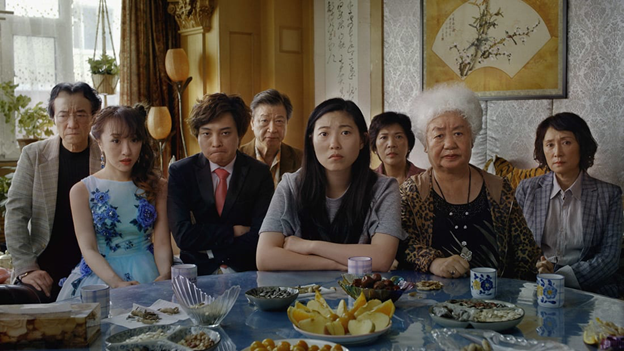 5. THE FAREWELL
5. THE FAREWELL
Director: Lulu Wang
Lulu Wang deserves a medal for her ability to take a vast anthropological concept like individualism vs. collectivism and find the heart. The aforementioned notion, however, is one tenant in a larger idea about THE FAREWELL and Lulu Wang as a whole—she is one of the most thoughtful directors of our generation. As kind as she seems from seeing her interviews, “thoughtful” relates more to her meticulous attention to even the smallest aspect of her films. Wang’s camerawork instantly comes to mind as truly notable. For the vast majority of the film, her camera is almost completely still and it doesn’t hit you until much later that it’s to reconstitute the throughline of “still waters run deep.” Awkwafina wants to scream and cry for her ailing grandmother because her Western upbringing tells her if she’s not exploding into absolute grief then she doesn’t really care, whereas her mother, and the rest of her family, show the validity of grieving in an introspective, silent way, per their collectivist mindset. Neither method is right or wrong, they’re simply two different opinions stemming from two different institutions. It is more than palpable that Awkwafina’s character Billi, a surrogate for Wang, has been battling with these conflicting ideologies most of her life and will be searching for balance indefinitely. [Jesse Herb]
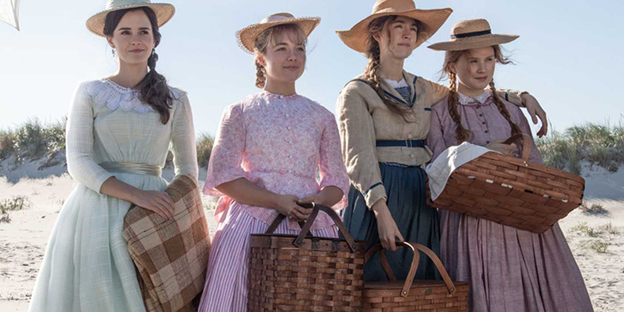 4. LITTLE WOMEN
4. LITTLE WOMEN
Director: Greta Gerwig
In the annals of history, perhaps only PRIDE AND PREJUDICE is a more dreaded secondary education reading assignment, but our Lord and Savior Greta Gerwig has knocked it far out of the park once again with her second feature film. This certainly shouldn’t be the first time you’ve heard it as far as this film is concerned: it takes a special talent to release the best adaptation of an IP in 2019 considering the first crack at it occurred in 1917, but there’s no question (or at least, there shouldn’t be) that this is the definitive portrayal of the Marsh women. There are troves of adulatory adjectives to be heaped upon the film, but the fact that it practically redefines “charming” is all that really needs to be said. Handled with a masterfully deft poise from Gerwig, every single frame exudes confidence and an undeniable love for the project, from the set design to the costuming to the intricate composition and everything in-between. An aesthetic masterpiece that never once loses sight of the fact that the story of the Marsh clan is as fun and humorous as it is tear-jerkingly tragic, ending up a layered and infinitely relatable vessel of the human experience, every actor is firing on all cylinders and anyone looking for a misstep to complain about is stretching their neck out for a deserved chopping block. LITTLE WOMEN gave me and many others across the nation one of the most rewarding evenings with their mothers they can point to, and I left the film more elated and full of hope and love than in any other film released last year. What more do you need? God bless these little women. [Thomas Seraydarian]
 3. PARASITE
3. PARASITE
Director: Bong Joon-ho
When you look at footage of Bong Joon-ho on his press tour for PARASITE, you see a man with relaxed confidence, a man who knows that he’s reached the height of his formidable powers. We waited this entire decade for a film like PARASITE, we waited for someone to make us look at our day-to-day reality and unequivocally say “this is fucked.” Income inequality was the driving force of so much of our lived experience of the 2010s, and yet it’s taken us a long time to find the language to describe how it feels. Bong provided us with that language, he lavished us in metaphors, stark contrasts, and images so precise that it became impossible to deny the contradictions he was showing us. It’s tough to say if PARASITE will sweep the Oscars this year, but it almost doesn’t matter: its shocking popularity in the US and around the globe is testament enough to its undeniable power. This haunted house fable is deliriously entertaining, and yet the longer I sit with it, the more it devastates me. The condition we find ourselves in is bleak, and Bong makes no attempt to hide that fact. And yet, by showing us the world as it really is, with no delusions, he grants us the gift of beginning to imagine something better. [Carter Moon]
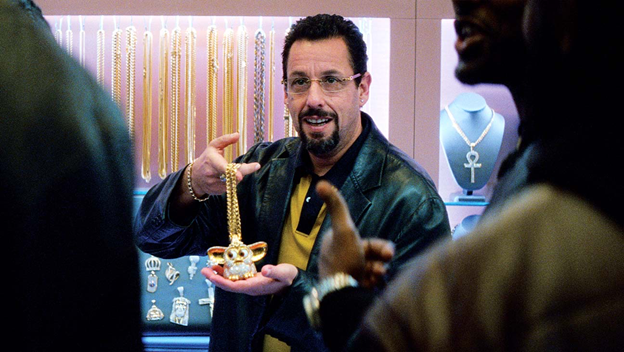 2. UNCUT GEMS
2. UNCUT GEMS
Director: The Safdie Brothers
Wow! This film is filthy! From the slime of grain smeared across every frame, to Adam Sandler’s smarmy turn so invasive you can almost smell the stale gum, tacky body-spray, and bad breath emanating from the screen… the Safdies’ latest is nothing if not authentic to the streets of New York. Their signature long-lensed style constantly makes us feel as if we’re peering across the street at the action, lets us be voyeurs on people as yucky as the colonoscopy the film opens with (giving us one of the year’s best transitions). The music is a synth-laden sonic orgasm. The pacing is propulsive—by the end, it never lets up. And it leads us to a conclusion at once shocking, inevitable, and even—dare I say it—happy. For better or for worse, Howard ends this film at the top of his game, and no matter the mortal consequences, we feel satisfied that we’ve climbed the mountain with him towards his ultimate dream. [Reid Antin]
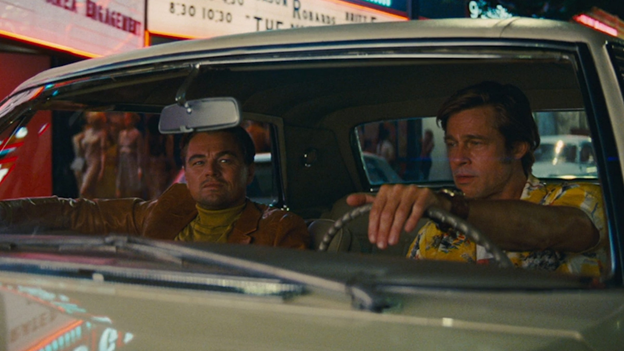 1. ONCE UPON A TIME… IN HOLLYWOOD
1. ONCE UPON A TIME… IN HOLLYWOOD
Director: Quentin Tarantino
To quote FLEABAG, “this is a love story.” Tarantino’s ninth feature, ONCE UPON A TIME… IN HOLLYWOOD claps a friendly hand on your shoulder and firmly guides you back to Los Angeles, 1969. The neon is bright, streets are clear, all is exactly as it used to be and, in a way, as it should be. Revered as a “hang-out movie” of sorts, ONCE UPON A TIME… follows washed-up Western star Rick Dalton and his stunt double-slash-driver Cliff Booth as the two navigate the end of Hollywood’s Golden Age, and young actress Sharon Tate as her era begins. There’s a quiet desperation to the film—Tarantino’s desperation to exist in a 1960s Hollywood manifests primarily through Rick’s desperate attempts to remain relevant, but quietly gnaws at the soul on late-night drives down Hollywood Boulevard, in the backyard of the Playboy Mansion, on a ranch in Chatsworth. It’s a dream, a fairytale, an alternate reality in which cowboys get a second chance, Sharon Tate is saved, and Brad Pitt is shirtless up on the roof. ONCE UPON A TIME… captures the spirit of Hollywood that was promised to every kid who found God in a movie theater, who worshiped by the crackle of 35mm film, and was guided by dim aisle lights to a pew. It’s the ceiling of the Sistine Chapel for The Golden Age of Hollywood, with references tucked into every corner, allegories weaving throughout the piece. If this is Tarantino’s farewell to filmmaking, so be it—ONCE UPON A TIME… is everything he represents, a love letter and a farewell note in the same envelope, sealed with the perfect post scriptum: “Come visit me tomorrow, bring bagels.” [Aya Lehman]



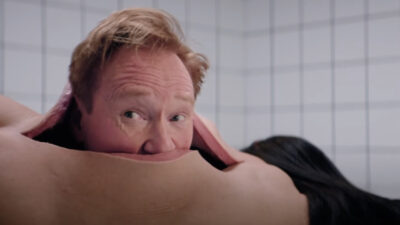

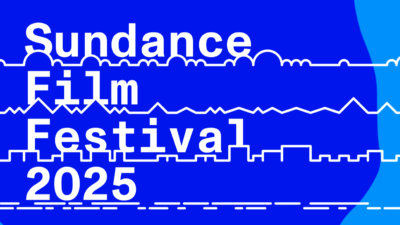






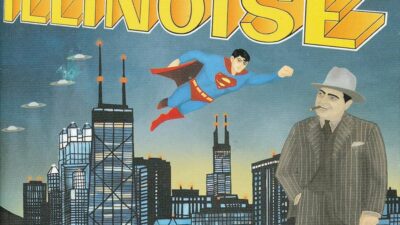



Comments